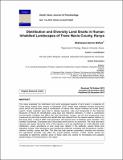Distribution and Diversity Land Snails in Human Inhabited Landscapes of Trans Nzoia County, Kenya
Abstract/
The study evaluated the distribution and some ecological aspects of land snails in croplands of Trans Nzoia, Kenya from January to December 2016. Snails were collected monthly during the study period and sampled using a combination of indirect litter sample methods and timed direct search. Snails collected were kept in labeled specimen vials and transported to the National Museums of Kenya for identification using keys and reference collection. In order to understand environmental variables that affect soil snail abundance; canopy, soil pH and temperature was measured per plot while humidity and rainfall data was obtained from the nearest weather stations to the study sites. A total of 2881 snail specimens (29 species from 10 families) were recorded. The families Subulinidae,Charopidae and Urocyclidae were found to be dorminant. The most abundant species was Opeas lamoense(12% of the sample). Land use significantly (p< 0.05) affected snail distribution, where abundance of land snails was highest in the wetlands, natural forest and plantation forests. Snail abundance was significantly positively correlated with temperature, rainfall, relative humidity, campy and litter. The area has high species composition, diversity and richness but agricultural activities may affect the overall species richness. Further studies should be conducted to determine whether some of these snails are vectors for trematodes and possible epidemiology of schistosomiasis in the region.Original ResearchArticle
Collections
- Department of Zoology [161]

